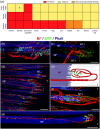Proprioceptors in extraocular muscles
- PMID: 36869596
- PMCID: PMC10988737
- DOI: 10.1113/EP090765
Proprioceptors in extraocular muscles
Abstract
Proprioception is the sense that lets us perceive the location, movement and action of the body parts. The proprioceptive apparatus includes specialized sense organs (proprioceptors) which are embedded in the skeletal muscles. The eyeballs are moved by six pairs of eye muscles and binocular vision depends on fine-tuned coordination of the optical axes of both eyes. Although experimental studies indicate that the brain has access to eye position information, both classical proprioceptors (muscle spindles and Golgi tendon organ) are absent in the extraocular muscles of most mammalian species. This paradox of monitoring extraocular muscle activity in the absence of typical proprioceptors seemed to be resolved when a particular nerve specialization (the palisade ending) was detected in the extraocular muscles of mammals. In fact, for decades there was consensus that palisade endings were sensory structures that provide eye position information. The sensory function was called into question when recent studies revealed the molecular phenotype and the origin of palisade endings. Today we are faced with the fact that palisade endings exhibit sensory as well as motor features. This review aims to evaluate the literature on extraocular muscle proprioceptors and palisade endings and to reconsider current knowledge of their structure and function.
Keywords: Golgi tendon organs; eye muscle; muscle spindles; palisade endings; proprioception.
© 2023 The Authors. Experimental Physiology published by John Wiley & Sons Ltd on behalf of The Physiological Society.
Conflict of interest statement
None declared.
Figures


References
-
- Abuel Atta, A. A. , DeSantis, M. , & Wong, A. (1997). Encapsulated sensory receptors within intraorbital skeletal muscles of a camel. Anatomical Record, 247(2), 189–198. - PubMed
-
- Alvarado‐Mallart, R. M. , & Pincon‐Raymond, M. (1979). The palisade endings of cat extraocular muscles: A light and electron microscope study. Tissue & Cell, 11(3), 567–584. - PubMed
Publication types
MeSH terms
Grants and funding
- P 20881/FWF_/Austrian Science Fund FWF/Austria
- MCIN/AEI FEDER 'A way of making Europe' and by project P20_00529 Consejería de Transformación Económica, Industria y Conocimiento, Junta de Andalucía-FEDER. P.M.C. is a 'Margarita Salas' fellow of the Universidad de SevillaMaterials were also supported by projects
- PGC2018-094654-B-100/Materials were also supported by projects
- P15478/Austrian Science Fund (FWF)
- P 32463/FWF_/Austrian Science Fund FWF/Austria
LinkOut - more resources
Full Text Sources
